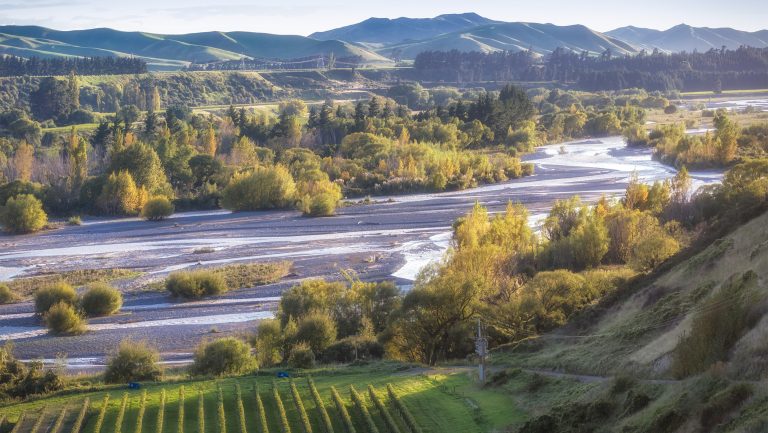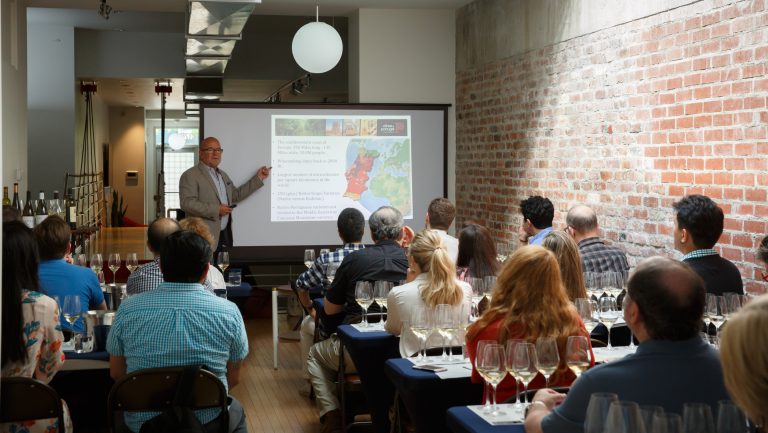This advertising content was produced in collaboration with our partner, Winebow.
Walking through pristine vineyards, it’s easy to focus on the lush green canopy of the orderly rows or the uniform grape bunches hanging beneath them at perfectly measured intervals. But admiring the landscape leaves a huge variable out of the proverbial equation—a factor the industry-leading team at Villa Maria believes is critical to crafting world-class wines and creating a viticultural landscape built for longevity and sustainability.
“Most people try to manage vineyards based on what you can see, but at least 50 percent of the vine is underground,” says Ollie Powrie, the winery’s chief viticulturist. “At Villa Maria, everything about our approach is focused on managing the entire vine ecosystem, not just the parts we can see.”
The holistic approach embraced by Powrie, coupled with modern technology, continues to set Villa Maria apart in New Zealand and around the world at a time when consumers are highly focused on sustainability. And Villa Maria’s efforts aren’t greenwashing: One of New Zealand’s founding wineries, the 60-year-old estate pioneered organic practices in the country back in 1999 and over 25 years ago was a founding member of Sustainable Winegrowing New Zealand.

Don’t miss the latest drinks industry news and insights. Sign up for our award-winning newsletters and get insider intel, resources, and trends delivered to your inbox every week.
With a holistic approach centered on four pillars—respecting the land, treading lightly, investing in people, and inspiring conscious consumption—Villa Maria is committed in the vineyards, cellar, and their global and local communities to reduce carbon emissions and waste at every step of the winemaking process.
“I love our approach because I think at the end of the day, it’s a focus on ultimately doing what we think is best for the land, the environment, and our waterways,” says Powrie. “It’s always been part of our mission, and yet we approach sustainability with a spirit of innovation. We’re not just doing things because they’ve always been done a certain way.”
Building Fruit Resilience Through Organics
With vineyards spanning Auckland, Marlborough, Gisborne, and Hawke’s Bay, Villa Maria is able to interpret terroir and experiment with sustainability practices on a grand scale—leading to innovations with massive impacts that can be shared throughout the country as more vintners move toward sustainable, low-impact farming techniques.
Villa Maria began farming organically in 1999, and 30 percent of their company-owned vineyards are currently managed organically. “It’s quite a volatile climate here, and we need to really watch it,” says Powrie of New Zealand’s maritime climate. “But the great thing and the outcome of growing organically is that the fruit’s naturally very resilient. We believe an entirely organic approach is the best way to achieve some of our really big goals, like moving away from herbicides and looking after the soil health.” The estate is on track to achieve 100 percent organic management of its own vineyards by 2030.

Powrie believes that a gentle transition is crucial to maintaining yields and keeping quality high during the transition to organics, which has inspired the Villa Maria team to reduce their environmental impact with imaginative, cutting-edge techniques while moving toward organic certification.
For example, Villa Maria now plants over 700 kilograms of native wildflower species in their vineyards to counteract weeds and improve soil health. “We just thought, ‘Why can’t we look at plant species that can live in harmony with the vine and then try and establish them so that we don’t have to be actively mowing them all the time?’” says Powrie. “That brainstorm led us to a project where we are trialling native plants that grow in our environment already and use those beneath the vines.”
The team has taken the same innovative approach—which Powrie cultivates via regular creative brainstorming sessions with vintners from across regions in New Zealand—to invigorating their composting regimen with worm farms and developing state-of-the-art underground irrigation systems.
“The desire to be more efficient with water use, that’s just part of our DNA,” says Powrie. “Because underground irrigation sends the water straight to the roots and it’s not evaporating, we were able to water less frequently. Since experimenting with this, we’ve planted four vineyards and implemented 100 percent underground irrigation, plus we’ve got several of our suppliers doing the same.”
Powrie estimates the switch to underground irrigation cut water usage by over 25 percent while concurrently reducing the need for maintenance crews to drive through the vineyards inspecting and repairing traditional drip irrigation systems. Resultantly, vineyard ecosystems are healthier and require fewer human resources to thrive, creating a cascade effect that continues to reduce Villa Maria’s reliance on fossil fuels, water, and harsh chemical inputs.
“If you’re just driving tractors through the vineyards, frankly, all you’re doing is treating what you can see visually and putting a tonic on the problem,” says Powrie. “We’re trying to manage the whole environment and look after the vines knowing that the decisions we make today will affect what these vineyards are like in 30 years.”
Making Better Wine While Reducing its Footprint
Inside the winery, the pioneering estate’s efforts to curb carbon emissions and invest in human capital are equally impressive. Since 2011, Villa Maria has utilized an all-electric fleet of forklifts, significantly reducing the estate’s reliance on fossil fuels. Currently, Villa Maria’s wineries are on track to operate on 100 percent renewable resources by 2035, and eliminate all waste sent to landfills by 2025.
Simultaneously, Villa Maria has reduced the weight of their bottles and are using recycled glass to cut shipping costs and reduce waste. Today, Villa Maria’s bottles are made up of 67 percent recycled materials on average, and they weigh 16 percent less than standard glass wine bottles. These innovations have led the estate to reduce its carbon emissions by a whopping 39 percent per bottle since 2009. The estate also uses a local bottling plant just 22 kilometers from their estate, reducing transit costs and supporting jobs in their local community.
“Ultimately, it’s all about wine quality for us,” says Powrie of their continued efforts inside and outside of their estate. “The lens that we look through is always focused on producing world-class wines from New Zealand.”
Combining quality with innovation has set Villa Maria apart since their founding in 1961, leading the estate to its status as New Zealand’s most-awarded winery. With Powrie at the helm and sustainability top of mind, there’s no doubt this Kiwi powerhouse will remain a leader in New Zealand and beyond.

Dispatch
Sign up for our award-winning newsletter
Don’t miss the latest drinks industry news and insights—delivered to your inbox every week.










